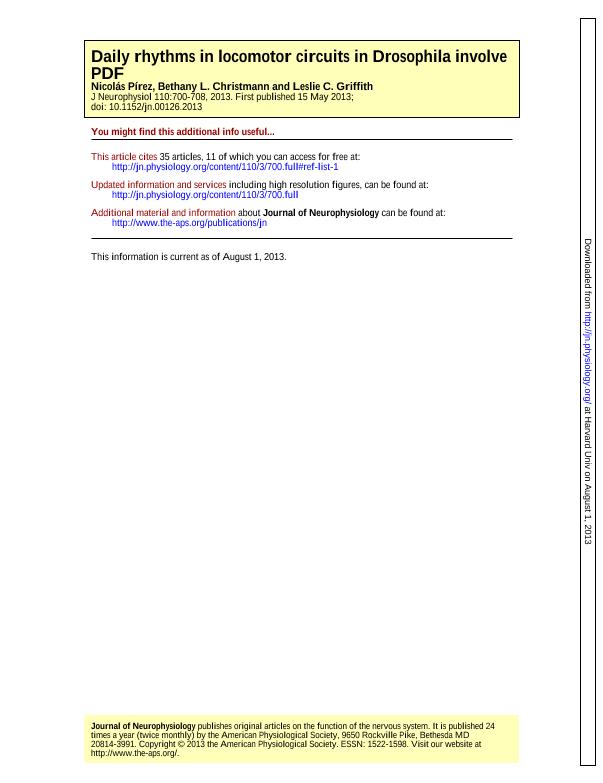Mostrar el registro sencillo del ítem
dc.contributor.author
Pírez, Nicolas

dc.contributor.author
Christmann, Bethany L.
dc.contributor.author
Griffith, Leslie C.
dc.date.available
2017-06-22T18:58:48Z
dc.date.issued
2013-05
dc.identifier.citation
Pírez, Nicolas; Christmann, Bethany L.; Griffith, Leslie C.; Daily rhythms in locomotor circuits in Drosophila involve PDF; American Physiological Society; Journal Of Neurophysiology; 110; 3; 5-2013; 700-708
dc.identifier.issn
0022-3077
dc.identifier.uri
http://hdl.handle.net/11336/18688
dc.description.abstract
The neuropeptide pigment-dispersing factor (PDF) has been studied extensively in Drosophila, and its role in circadian time-keeping has been firmly established. The role of PDF outside of the clock circuit, however, is poorly understood. A recent study suggested that PDF may act on the ellipsoid body (EB) to link the clock and sleep/activity circuits. We performed whole brain optical imaging with the fluorescence resonance energy transfer (FRET)-based cAMP sensor Epac1-camps expressed under control of the pdfR promoter to address how the clock and sleep deprivation affect the physiology of these cells. Basal cAMP levels in EB were regulated both by PDF and synaptic inputs that are controlled by the circadian clock. Acute application of PDF to the brain caused a significant, and PDF-receptor-dependent, increase in cAMP in EB cells. Application of TTX to block circuit-mediated effects of PDF increased the morning response but not the response at night, implying the existence of a temporally regulated, PDF-stimulated input that blocks cAMP generation. ACh produced both direct (TTX-insensitive) and indirect (TTX-sensitive) increases in cAMP during the day but was totally TTX-insensitive at night, indicating that ACh-stimulated inputs to the EB are suppressed at night. Sleep deprivation did not affect the cAMP responses of these cells to either PDF or ACh. These results suggest a novel role for PDF as a modulator of activity outside of the clock circuit. By elucidating the mechanisms by which the neuropeptide PDF act on its target cells, our work contributes to our understating of how the central clock coordinates activity and sleep.
dc.format
application/pdf
dc.language.iso
eng
dc.publisher
American Physiological Society

dc.rights
info:eu-repo/semantics/openAccess
dc.rights.uri
https://creativecommons.org/licenses/by-nc-sa/2.5/ar/
dc.subject
Camp Imaging
dc.subject
Sleep
dc.subject
Neuropeptide Pdf
dc.subject
Ellipsoid Body; Circadian Clock
dc.subject.classification
Otros Tópicos Biológicos

dc.subject.classification
Ciencias Biológicas

dc.subject.classification
CIENCIAS NATURALES Y EXACTAS

dc.title
Daily rhythms in locomotor circuits in Drosophila involve PDF
dc.type
info:eu-repo/semantics/article
dc.type
info:ar-repo/semantics/artículo
dc.type
info:eu-repo/semantics/publishedVersion
dc.date.updated
2016-09-05T13:12:55Z
dc.identifier.eissn
1522-1598
dc.journal.volume
110
dc.journal.number
3
dc.journal.pagination
700-708
dc.journal.pais
Estados Unidos

dc.journal.ciudad
Bethesda
dc.description.fil
Fil: Pírez, Nicolas. Brandeis University. Department of Biology; Estados Unidos. Consejo Nacional de Investigaciones Científicas y Técnicas. Oficina de Coordinación Administrativa Parque Centenario. Instituto de Investigaciones Bioquímicas de Buenos Aires. Fundación Instituto Leloir. Instituto de Investigaciones Bioquímicas de Buenos Aires; Argentina
dc.description.fil
Fil: Christmann, Bethany L.. Brandeis University. Department of Biology; Estados Unidos
dc.description.fil
Fil: Griffith, Leslie C.. Brandeis University. Department of Biology; Estados Unidos
dc.journal.title
Journal Of Neurophysiology

dc.relation.alternativeid
info:eu-repo/semantics/altIdentifier/url/http://jn.physiology.org/content/110/3/700.long
dc.relation.alternativeid
info:eu-repo/semantics/altIdentifier/doi/http://dx.doi.org/10.1152/jn.00126.2013
Archivos asociados
